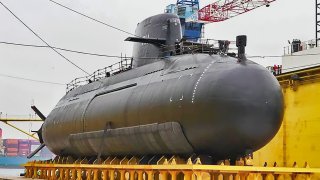Hai Kun: Taiwan's First Domestic Submarine Is a Real Game Changer
Taiwan launched its first Indigenous Defense Submarine (IDS), the Hai Kun (SS-711), marking a significant step in its "Domestic Ship, Domestically Built" policy. Constructed in Kaohsiung's CSBC shipyard, the submarine underwent critical tests during its Harbor Acceptance Trial, including watertight, stability, and ballast control tests.
Summary: Taiwan launched its first Indigenous Defense Submarine (IDS), the Hai Kun (SS-711), marking a significant step in its "Domestic Ship, Domestically Built" policy. Constructed in Kaohsiung's CSBC shipyard, the submarine underwent critical tests during its Harbor Acceptance Trial, including watertight, stability, and ballast control tests. With propulsion and subsystem checks upcoming, the Hai Kun aims for delivery by year-end. Taiwan's move to build its own submarines comes after years of international supply challenges, creating a fleet to bolster its defenses against China. The project leverages global expertise, reflecting a strong international collaboration in developing a sophisticated naval asset.
Taiwan's Milestone in Defense: Launching Its First Domestically Built Submarine
Last week, the self-ruling island of Taiwan sought to ensure it will remain self-ruling with the launch of its first Indigenous Defense Submarine (IDS) at the CSBC shipyard in Kaohsiung. The submarine was part of Taipei’s “Domestic Ship, Domestically Built” policy.
The submarine, the Hai Kun (SS-711), was transferred from its construction hall to a specially built 35,000-ton floating dry dock for ongoing work.
Trials have already begun on the vessel.
According to a report from Naval News, during the first phase of the Harbor Acceptance Trial, CSBC successfully conducted the critical watertight test, weight distribution control, ballast control, and stability control test of the sub’s hull. In the second phase of the Harbor Acceptance Trial in the coming months, the Hai Kun will go through propulsion system checks, subsystem checks, calibration, and follow-on installation works of the batteries and various Mast Raising Equipment, including the Optronics, ESM, Radar, and Communication Masts.
Following the installation of the equipment, the submarine will undergo Sea Acceptance Trials and could be delivered to the Taiwanese Navy by the year’s end.
Taiwan: Building its Own Submarines
Taiwan has maintained a small force of antiquated submarines as it sought to acquire more modern vessels for years. Due to political pressure from Beijing, Taipei could not find any suppliers—and, as a result, set out to build its own. As part of the efforts, Taiwan designed and built a new shipyard in the city of Kaohsiung, where it stealthily recruited experts and gathered technology from around the world. It began constructing a fleet of eight modern conventionally-powered attack submarines earlier this decade.
The first of those boats was unveiled last September.
The Hai Kun is the first of the eight new submarines being developed under a multibillion-dollar program that could bolster Taiwan’s naval defenses in the event of war with China. The new submarine is reported to be around 260 feet long and has a displacement of between 2,460 and 2,950 tons.
An International Effort
Although Taipei has invested significantly in building the subs, its program has also drawn from an international coalition, which has provided the technical expertise and components.
Taiwan hired engineers, technicians, and former naval officers from several countries, including Australia, South Korea, India, Spain, and Canada, to bolster its domestic submarine program.
Though the United States and the UK wouldn’t actually sell a completed boat to Taiwan—in part because each has only nuclear-powered submarines and doesn’t build diesel-electric boats—each nation has provided the technology, including combat system components and sonar arrays. In recent years, the UK even approved multiple export licenses for British-based companies to supply critical parts, technology, and software.
Taiwan’s domestically-built subs have some characteristics of Western-made submarines, notably the U.S. Navy’s Virginia-class as the Hai Kun-class utilize masts supplied by L3 Harris, which are expected to include electro-optical “periscopes.” Those masts are similar to the ones aboard the Virginia class and have several advantages, including the fact that they do not penetrate the hull. Hence, they are safer for the boat if it accidentally hits a ship. Another advantage is that they are modular, meaning new masts can easily be switched in or out. The modern optics also means that the periscope doesn’t have to be raised for as long, so it is less likely to be detected.
The Taiwanese Navy’s submarine will likely be armed with the U.S.-supplied MK-48 Mod6 Advanced Technology (AT) heavyweight torpedoes—which were approved for sale to Taiwan in 2020 – along with a submarine-launched version of the U.S. Navy’s Harpoon anti-ship missile. The UGM-84 Sub-Harpoon is currently in service with Taiwan aboard the Hai Lung class of subs.
Author Experience and Expertise: Peter Suciu
Peter Suciu is a Michigan-based writer. He has contributed to more than four dozen magazines, newspapers, and websites, with over 3,200 published pieces over a twenty-year career in journalism. He regularly writes about military hardware, firearms history, cybersecurity, politics, and international affairs. Peter is also a Contributing Writer for Forbes and Clearance Jobs. You can follow him on Twitter: @PeterSuciu. You can email the author: [email protected].
Image Credit: Taiwan Government Handout.


